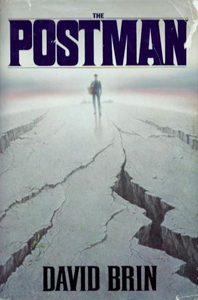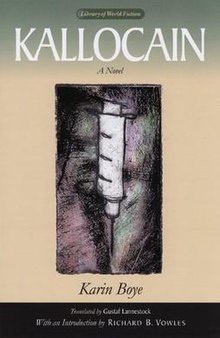
Brave New World is a dystopian novel by English author Aldous Huxley, written in 1931 and published in 1932. Largely set in a futuristic World State, whose citizens are environmentally engineered into an intelligence-based social hierarchy, the novel anticipates huge scientific advancements in reproductive technology, sleep-learning, psychological manipulation and classical conditioning that are combined to make a dystopian society which is challenged by the story's protagonist. Huxley followed this book with a reassessment in essay form, Brave New World Revisited (1958), and with his final novel, Island (1962), the utopian counterpart. This novel is often compared to George Orwell's 1984 (1949).
Utopian and dystopian fiction are subgenres of science fiction that explore social and political structures. Utopian fiction portrays a setting that agrees with the author's ethos, having various attributes of another reality intended to appeal to readers. Dystopian fiction offers the opposite: the portrayal of a setting that completely disagrees with the author's ethos. Some novels combine both genres, often as a metaphor for the different directions humanity can take depending on its choices, ending up with one of two possible futures. Both utopias and dystopias are commonly found in science fiction and other types of speculative fiction.

The Postman is a post-apocalyptic dystopia science fiction novel by David Brin. It is about a man wandering the desolate Oregon countryside who finds a United States Postal Service uniform, which he puts on and then claims he is a mail carrier and federal inspector for the "Restored United States of America". His mail service and claims about the return of a central government gives hope to the people, who are threatened by a murderous, neo-feudalist militia.

Karin Maria Boye was a Swedish poet and novelist. In Sweden, she is acclaimed as a poet, but internationally, she is best known for the dystopian science fiction novel Kallocain (1940).
The Hugo Award for Best Novel is one of the Hugo Awards given each year for science fiction or fantasy stories published in, or translated to, English during the previous calendar year. The novel award is available for works of fiction of 40,000 words or more; awards are also given out in the short story, novelette, and novella categories. The Hugo Awards have been described as "a fine showcase for speculative fiction", and "the best known literary award for science fiction writing".
The Hugo Award for Best Novella is one of the Hugo Awards given each year for science fiction or fantasy stories published or translated into English during the previous calendar year. The novella award is available for works of fiction of between 17,500 and 40,000 words; awards are also given out in the short story, novelette and novel categories. The Hugo Awards have been described as "a fine showcase for speculative fiction" and "the best known literary award for science fiction writing".

The Hugo Award for Best Novelette is one of the Hugo Awards given each year for science fiction or fantasy stories published or translated into English during the previous calendar year. The novelette award is available for works of fiction of between 7,500 and 17,500 words; awards are also given out in the short story, novella and novel categories. The Hugo Awards have been described as "a fine showcase for speculative fiction" and "the best known literary award for science fiction writing".
The Hugo Award for Best Short Story is one of the Hugo Awards given each year for science fiction or fantasy stories published or translated into English during the previous calendar year. The short story award is available for works of fiction of fewer than 7,500 words; awards are also given out for pieces of longer lengths in the novelette, novella, and novel categories. The Hugo Awards have been described as "a fine showcase for speculative fiction" and "the best known literary award for science fiction writing".

Slan is a science fiction novel by American-Canadian writer A. E. van Vogt, as well as the name of the fictional race of superbeings featured in the novel. The novel was originally serialized in the magazine Astounding Science Fiction. It was subsequently published in hardcover in 1946 by Arkham House, in an edition of 4,051 copies. In 2016, Slan was awarded the Retro-Hugo Award for Best Novel for 1941.
The exploration of politics in science fiction is arguably older than the identification of the genre. One of the earliest works of modern science fiction, H. G. Wells’ The Time Machine, is an extrapolation of the class structure of the United Kingdom of his time, an extreme form of social Darwinism; during tens of thousands of years, human beings have evolved into two different species based on their social class.
Charlotte Haldane was a British feminist writer. Her second husband was the biologist J.B.S. Haldane.
Social science fiction is a subgenre of science fiction, usually soft science fiction, concerned less with technology/space opera and more with speculation about society. In other words, it "absorbs and discusses anthropology" and speculates about human behavior and interactions.

An Age is a 1967 science fiction novel by English writer Brian Aldiss. The book, set principally in 2093, combines the popular science fiction themes of time travel, totalitarian dystopia, and the untapped potential of the human mind. It was nominated for a Ditmar Award in 1969 in the "Best International Science Fiction of any length, or collection" category.
The period of Modernistic Swedish literature started in the 1910s. Some regard 1910 itself as the beginning, when August Strindberg published several critical newspaper articles, contesting many conservative values. Several other years are also possible. What is undisputed is that with the advent of social democracy and large labor strikes, the winds of the 1910s blew in the direction of a working class reformation
David McDuff is a Scottish translator, editor and literary critic.

A dystopia, also called a cacotopia or anti-utopia, is a speculated community or society that is undesirable or frightening. It is often treated as an antonym of utopia, a term that was coined by Sir Thomas More and figures as the title of his best known work, published in 1516, which created a blueprint for an ideal society with minimal crime, violence, and poverty. The relationship between utopia and dystopia is in actuality, not one simple opposition, as many utopian elements and components are found in dystopias as well, and vice versa.
Nineteen Eighty-Four is a dystopian social science fiction novel and cautionary tale by English writer George Orwell. It was published on 8 June 1949 by Secker & Warburg as Orwell's ninth and final book completed in his lifetime. Thematically, it centres on the consequences of totalitarianism, mass surveillance and repressive regimentation of people and behaviours within society. Orwell, a democratic socialist, modelled the authoritarian state in the novel on the Soviet Union in the era of Stalinism, and Nazi Germany. More broadly, the novel examines the role of truth and facts within societies and the ways in which they can be manipulated.

The Hugo Award for Best Graphic Story is given each year for science fiction or fantasy stories told in graphic form and published or translated into English during the previous calendar year. It has been awarded annually since 2009. The Hugo Awards have been described as "a fine showcase for speculative fiction" and "the best known literary award for science fiction writing".

Aspects of genetics including mutation, hybridisation, cloning, genetic engineering, and eugenics have appeared in fiction since the 19th century.









